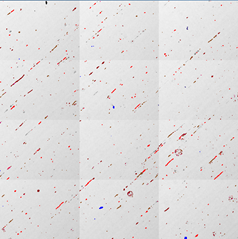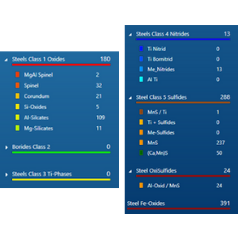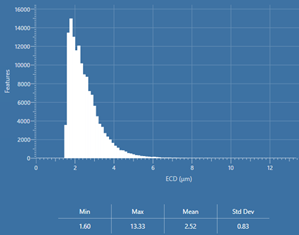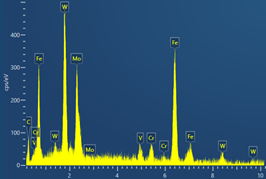产品
FIB-SEM
Nanomanipulators
OmniProbeOmniProbe Cryo软件
AZtec3DAZtecFeatureAZtec LayerProbeTEM
Hardware
EDSUltim MaxXploreImaging
软件
AZtecTEM
07th October 2020 | Author: Dr Hui Jiang
Steels are used for a wide range of purposes with their properties optimised for the particular application. The presence of non-metallic inclusions in steel can have a significant effect on that steel’s properties. Therefore, monitoring, characterising, and controlling the presence of inclusions in steels is a vital task to ensure that the correct properties are delivered. When investigating the influence of non-metallic inclusions on the quality of steel, chemical, size, distribution and physical characteristics of these inclusions are of great importance. As the demand for clean and ultraclean steels increases, there is also a requirement to detect smaller and smaller inclusions in larger sample areas.
This is best addressed by using the scanning electron microscope (SEM) equipped with Energy Dispersive X-ray microanalysis (EDS) and a dedicated particle analysis software such as AZtecSteel. The use of SEM and EDS adds further precision as morphology can be more precisely determined (on the micro- and nanometre scale) while adding chemical information to the characterisation.
The SEM is a powerful tool for the imaging of small particles. By combining the SEM with an EDS system, chemical information can additionally be obtained. Read on to see several examples of steel inclusions being interrogated using AZtecSteel.
The image below shows a montaged image from a low alloy steel over a large area with 2724 inclusions detected and analysed in 32 mins. It indicates the presence of various oxides, nitrides, and sulfides. It is mainly dominated by inclusions of Al-silicates and MnS. Many of them are elongated in shape and are observed forming strings. Inclusions in low alloy-steels are the main cause for pitting initiation, with sulfide inclusions more likely to cause pitting corrosion than other inclusions. This result helps to determine whether or not further processing optimisation is required to reduce the number of sulphide inclusions.

Inclusions meeting detection criteria are detected and coloured in a large area in the low alloy steel.

Classification totals and colour keys.
Here is another example of a standard economical molybdenum high-tenacity high-speed steel (HSS).
HSS is one of the most important materials for manufacturing drills, dies, and other cutting tools. The composition of HSS usually contains cobalt, molybdenum, tungsten, and vanadium, which can all form carbides. Contrary to other inclusions, these carbides can enhance hardness and wear resistance. Quality of HSS greatly depends on the type, the size, and the distribution of carbides in the matrix. Therefore, identification and quantification of such particles appears to be of great interest, especially in the correlations between microstructure and mechanical properties prospects.
The data was collected in an area covering 11mm2 with 150563 particles found and analysed. There are both inclusions and carbides in the sample as shown in Table below, however carbides account for the vast majority. The type of carbides is Mo-W-carbide.
| Al inclusion Classification Results Summary | |
| Class | Features |
| MgAl Spinel | 25 |
| Spinel | 4 |
| Corundum | 1 |
| Al- Silicates | 3 |
| Me Nitrides | 29 |
| Me- Sulfides | 6381 |
| (Ca, Mn) S | 14 |
| Al-Oxid / MnS | 1 |
| Mo-W-Carbides | 144085 |
All inclusion classification summary in a high-speed steel sample
Particles with ECD >1.6mm were detected. 144085 detected Mo-W carbides have a mean ECD of 2.5mm, shown in the histogram below.

Histogram of ECD of detected Mo-W carbides
Here is a typical single field BSE image showing the carbides distribution and typical spectrum acquired from Mo-W-carbides. You can see that the carbides distribution is not very uniform, most of the carbides are spherical, but there are banded carbides regions and clusters of carbides.

BSE image showing Mo-W carbides distribution in a single field

Typical spectrum acquired from Mo-W-carbides
Such results are helpful to understand the influence of the carbide size and distribution on the character of steel and tool life. Processing can be then optimised to further improve the mechanical property by refining carbide size and uniform the carbide distribution. Also, a detailed investigation of carbides at different process stages is important on evaluation and understanding the formation and transformation of carbides in high-speed steels.
Hopefully, this gives you an insight of steel inclusion analysis performed with AZtecSteel, our automated steel inclusion analysis package. To receive relevant updates on the product, application or other similar topics join our mailing list today.
Sign up nowWe send out monthly newsletters keeping you up to date with our latest developments such as webinars, new application notes and product updates.
 公安机关备案号31010402003473
公安机关备案号31010402003473